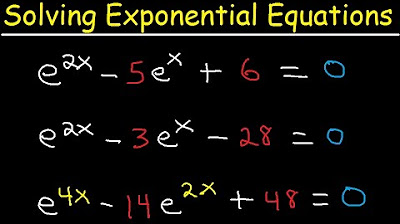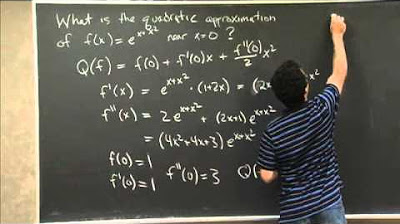How To Solve Quadratic Equations By Factoring - Quick & Simple! | Algebra Online Course
TLDRThis video lesson teaches the technique of solving quadratic equations by factoring. It covers the difference of perfect squares, extracting the greatest common factor (GCF), and factoring trinomials with leading coefficients other than one. The script provides step-by-step examples, including solving equations like x^2 - 49 = 0, 3x^2 - 75 = 0, and 8x^2 + 2x - 15 = 0. It also compares factoring to using the quadratic formula, demonstrating both methods for equations like x^2 - 2x - 15 = 0 and 8x^2 + 2x - 15 = 0, showing that both approaches yield the same solutions.
Takeaways
- 📚 The lesson focuses on solving quadratic equations by factoring, specifically using the difference of perfect squares technique.
- 🔍 For the equation x^2 - 49 = 0, the square roots of the terms are used to factor it into (x + 7)(x - 7), leading to solutions x = 7 and x = -7.
- 📉 In the case of 3x^2 - 75 = 0, the greatest common factor (GCF) is first extracted, simplifying the equation to x^2 - 25, which factors into (x + 5)(x - 5) with solutions x = 5 and x = -5.
- 📈 The script demonstrates how to handle equations like 9x^2 - 64 = 0 by taking square roots of the coefficients and factoring into (3x + 8)(3x - 8), yielding solutions x = -8/3 and x = 8/3.
- 🔑 For trinomials like x^2 - 2x - 15, finding two numbers that multiply to the constant term and add to the linear coefficient is key to factoring.
- 🔍 The trinomial x^2 + 3x - 28 is factored by identifying numbers that multiply to -28 and add to 3, resulting in the factored form (x - 4)(x + 7) with solutions x = 4 and x = -7.
- 📝 When the leading coefficient is not one, as in 8x^2 + 2x - 15, the script shows how to adjust the equation to make the leading coefficient one before factoring by grouping.
- 🔢 The quadratic formula x = (-b ± √(b^2 - 4ac))/2a is introduced as an alternative method to solve quadratic equations, demonstrated with the equation x^2 - 2x - 15.
- 📉 The script provides a step-by-step application of the quadratic formula to the equation 8x^2 + 2x - 15, resulting in solutions x = 5/4 and x = -3/2.
- 📚 The lesson concludes by emphasizing that quadratic equations can be solved either by factoring or by using the quadratic formula, providing flexibility in problem-solving approaches.
Q & A
What is the technique used to solve the equation x^2 - 49 = 0?
-The difference of perfect squares technique is used. The square root of x^2 is x, and the square root of 49 is 7, leading to the factors (x + 7) and (x - 7).
How do you find the value of x when you have the equation x^2 - 49 = 0 after factoring?
-Set each factor equal to zero: x + 7 = 0 and x - 7 = 0. Solving these gives x = -7 and x = 7, respectively.
What is the greatest common factor (GCF) of the equation 3x^2 - 75?
-The GCF of 3x^2 - 75 is 3. Factoring out the GCF gives x^2 - 25.
How can you solve the equation 3x^2 - 75 = 0 after factoring out the GCF?
-After factoring to x^2 - 25, use the difference of perfect squares technique to get (x + 5) and (x - 5), then set each equal to zero to find x = -5 and x = 5.
What is the method to solve the equation 9x^2 - 64 = 0?
-Apply the difference of perfect squares technique directly to the equation to get (3x + 8) and (3x - 8), then solve for x to find x = -8/3 and x = 8/3.
How do you factor the trinomial x^2 - 2x - 15?
-Find two numbers that multiply to -15 and add to -2. The correct pair is -5 and 3, leading to the factored form (x - 5)(x + 3).
What is the process for factoring a trinomial with a leading coefficient other than one, such as in the equation 8x^2 + 2x - 15?
-Multiply the leading coefficient and the constant term (8 * -15 = -120), then find two numbers that multiply to -120 and add to 2. The correct pair is 10 and -12, leading to the factored form (4x + 3)(2x - 5).
How do you solve for x in the quadratic equation using the quadratic formula?
-Use the formula x = -b ± √(b^2 - 4ac) / 2a, where a, b, and c are coefficients from the standard form of the quadratic equation ax^2 + bx + c = 0.
What are the solutions for the equation x^2 - 2x - 15 = 0 using the quadratic formula?
-Using the quadratic formula with a = 1, b = -2, and c = -15, the solutions are x = 5 and x = -3.
How do you find the values of x for the equation 8x^2 + 2x - 15 using the quadratic formula?
-With a = 8, b = 2, and c = -15, apply the quadratic formula to find the solutions x = 5/4 and x = -3/2.
What is the significance of the quadratic formula in solving quadratic equations?
-The quadratic formula provides a universal method to find the solutions for any quadratic equation, regardless of whether it can be factored easily.
Outlines
📚 Solving Quadratic Equations by Factoring
This paragraph introduces the method of solving quadratic equations through factoring. It begins with an example of the equation x^2 - 49 = 0, demonstrating the use of the difference of squares technique to factor it into (x + 7)(x - 7). The process involves setting each factor equal to zero to find the values of x, resulting in x = -7 and x = 7. The paragraph proceeds with another example, 3x^2 - 75 = 0, where the greatest common factor (GCF) is extracted, and the difference of squares is applied to factor the equation into (x + 5)(x - 5), yielding solutions x = -5 and x = 5. The paragraph also covers the factoring of 9x^2 - 64 = 0, using square roots to factor it into (3x + 8)(3x - 8), with solutions x = -8/3 and x = 8/3. Lastly, it discusses factoring a trinomial x^2 - 2x - 15 by finding two numbers that multiply to -15 and add up to -2, resulting in the factored form (x - 5)(x + 3) with solutions x = 5 and x = -3.
🔍 Factoring Quadratics with Non-Unity Leading Coefficients
This section delves into factoring quadratic equations where the leading coefficient is not one. It starts with an example of 8x^2 + 2x - 15 and explains the process of finding two numbers that multiply to -120 and add up to 2, which are 10 and -12. The equation is then rewritten as 4x(2x + 3) - 5(2x + 3) and factored by grouping into (2x + 3)(4x - 5). Solving for x gives two solutions: x = -3/2 and x = 5/4. The paragraph also revisits a previous problem, x^2 - 2x - 15, and solves it using the quadratic formula, demonstrating the steps to arrive at the same solutions, 5 and -3, using this alternative method. The summary underscores the flexibility of solving quadratic equations through factoring or the quadratic formula.
📘 Applying the Quadratic Formula to Solve Quadratics
This paragraph focuses on solving quadratic equations using the quadratic formula: x = (-b ± √(b^2 - 4ac)) / (2a). It illustrates the process with the equation 8x^2 + 2x - 15, identifying a = 8, b = 2, and c = -15. The formula is applied step by step, with b^2 - 4ac calculated as 4 - 4 * 8 * (-15), resulting in 484. The square root of 484 is 22, leading to the solutions (-2 ± 22) / 16, which simplifies to 5/4 and -3/2. The paragraph emphasizes the quadratic formula as a reliable method for solving quadratic equations, providing a systematic approach to finding the values of x.
Mindmap
Keywords
💡Quadratic Equations
💡Factoring
💡Difference of Perfect Squares
💡Greatest Common Factor (GCF)
💡Square Root
💡Trinomial
💡Quadratic Formula
💡Leading Coefficient
💡Factor by Grouping
💡Coefficients
Highlights
Introduction to solving quadratic equations by factoring.
Example of solving x^2 - 49 = 0 using the difference of squares technique.
Explanation of setting each factor equal to zero to find the value of x.
Demonstration of solving 3x^2 - 75 = 0 by taking out the GCF and using the difference of squares.
Solving 9x^2 - 64 = 0 by applying the difference of squares technique directly.
How to factor a trinomial with a leading coefficient of one, using x^2 - 2x - 15 as an example.
Finding two numbers that multiply to -15 and add to -2 for factoring.
Solving x^2 + 3x - 28 by identifying numbers that multiply to -28 and add to 3.
Approach to factoring trinomials when the leading coefficient is not one, using 8x^2 + 2x - 15 as an example.
Using the quadratic formula to solve quadratic equations, with a step-by-step guide.
Application of the quadratic formula to the equation 8x^2 + 2x - 15.
Explanation of how to handle the quadratic formula when the discriminant is a perfect square.
How to solve for x when the leading coefficient is not one, using 8x^2 + 2x - 15 as an example again.
The process of factoring by grouping and finding the GCF for each group.
Final solutions to the quadratic equations using both factoring and the quadratic formula.
Summary of the lesson on solving quadratic equations by factoring and using the quadratic formula.
Transcripts
Browse More Related Video

Solving a trigonometric equation by factoring

Solving Exponential Equations In Quadratic Form - Using Logarithms, With e

Writing Polynomial Functions With Given Zeros | Precalculus

Solving a quadratic equation by factoring | Algebra II | Khan Academy

Quadratic Approximation | MIT 18.01SC Single Variable Calculus, Fall 2010

Factoring Trinomials & Polynomials, Basic Introduction - Algebra
5.0 / 5 (0 votes)
Thanks for rating: